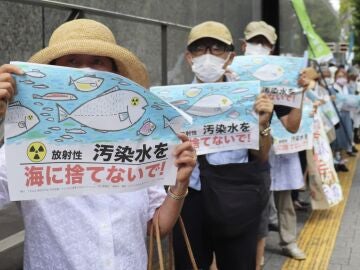
Japan began on Thursday to dump contaminated water into the Pacific from the damaged nuclear plant in fukushima after being treated to remove most of the radioactive waste, a process that will take several decades and continues generating protests inside and outside the country.
The spill began around 1:00 p.m. this Thursday after the last checks were carried out regarding the water pumps and some valves were opened manually, as announced by the company responsible for the damaged plant, TEPCO. “Each process must be carried out very firmly. Under the guidance of the Government, we will fulfill our responsibility“said Junichi Matsumoto, head of the initiative, at a press conference where he also explained that the discharge would stop if some type of anomaly was detected.
This discharge comes twelve years after the nuclear crisis caused by the earthquake and tsunami that took place in this japan area and after a cleaning process. In addition, the operator of the Tokyo Electric Power plant (TEPCO) decided to proceed with the dumping this Thursday after making sure that the concentration of radioactive waste was within the stipulated limits and has verified that there are no irregularities in its systems after the launch today by of North Korea of an alleged space vehicle, which caused the momentary activation of the anti-missile alert in the south of the Japanese archipelago.
The Japanese Executive decided in 2021 to resort to controlled discharge into the sea as a way to get rid of the contaminated liquid that accumulates in nuclear facilities, where space is running out for the large tanks that store it, and what is considered a fundamental step to the dismantling of the plant. The polluted water is treated with the ALPS systemcapable of completely removing 62 types of radioactive materials, with the exception of tritium and carbon-14.
The first discharge will last for 17 days and will consist of some 7,800 tons of water. Due to the total accumulated volume (1.34 million tons) and the fact that it increases on a daily basis, it is expected that the spill lasts for about 30 years.
Protests in Japan and around the world
The national federation of fishing cooperatives maintains a firm rejection of this planarguing that the measure will prevent Fukushima fishermen from getting rid of the radioactive stigma that has hung over their catches since 2011. Certain voices from the international scientific community and environmental organizations such as Greenpeace have also positioned themselves against the dumping. the security guarantees presented are insufficientas well as neighboring countries, especially China.
This same Thursday, various environmental and anti-nuclear citizen platforms called for new demonstrations in different parts of Japan in rejection of the measure. In South Korea, several citizen protests and another by the main opposition bloc, the liberal Democratic Party (PD), were also organized today. Municipal and provincial governments across the country have promised to increase radiation controls on fish and shellfish.
Beijing, for its part, announced today the suspension of the importation of seafood products of Japanese origin “to prevent the risk of radioactive contamination” due to the spill, after having urged Japan in previous days to cancel its plan. The Filipino fishermen’s union Pamalakaya and the Pacific Islands Forum also expressed their concern on Thursday about the possible impact of the measure.
Source: Lasexta
Ricardo is a renowned author and journalist, known for his exceptional writing on top-news stories. He currently works as a writer at the 247 News Agency, where he is known for his ability to deliver breaking news and insightful analysis on the most pressing issues of the day.












